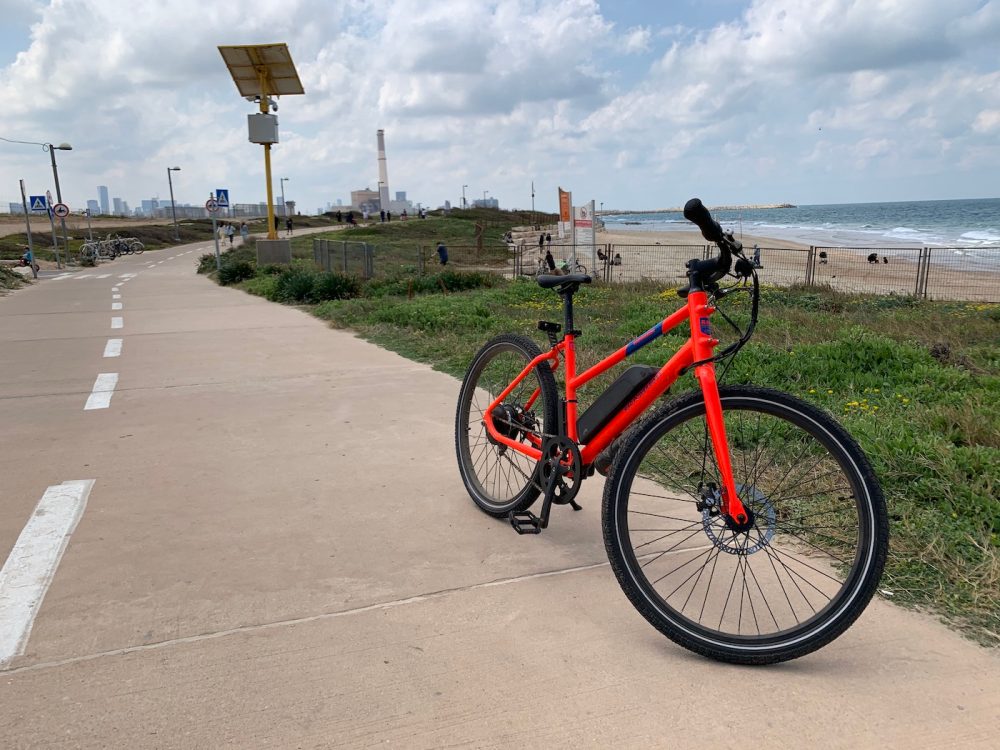
I first found my way into electric bicycles over 10 years ago as a form of alternative urban transportation. But lately I’ve been getting more into gravel riding for fitness. And in my never-ending quest to find more affordable ways to help get people onto their first electric bicycle, I decided to take a value-priced e-bike on a gravel ride to see how it would go.
If you’re not already familiar, gravel bikes or gravel riding make up one of the more increasingly popular trends in cycling.
Gravel riding combines road cycling and mountain biking, usually consisting of longer rides over unpaved roads and trails.
Thus gravel bikes are usually designed as a hybrid somewhere in the middle of the two disciplines. They lack the suspension of mountain bikes and instead take on a more road bike form, but are built to be more rugged and designed with features such as larger clearance for dirt and gravel-ready tires.
Dedicated gravel e-bikes exist – one of my favorites that I’ve tested is the Yamaha Wabash. At $3,499 it is worth every penny in my opinion, but it’s still far outside the price range of many potential new e-bike riders.
So I decided to try my hand at a gravel ride on something more affordable. The bike I chose was the RadMission from Rad Power Bikes. , it offers great specs including a 500 W motor and 500 Wh battery.
There’s no suspension since this is really more of a metro commuter e-bike, but gravel bikes are usually built on road-style frames anyway, so it fits the bill in that regard.
It also comes with 1.95″ tires with a moderate tread that finds a happy middle ground somewhere between slick road tires and knobby off-road tires.
It is by no means a gravel e-bike, at least it wasn’t intended to be.
But I don’t let little things like intentions stop me.
My best friend is a gravel riding enthusiast and lifelong cyclist, and we set out on a ride together to see if I could keep up. He was on a real gravel bike – one that cost three times as much as my e-bike. On the same bikes I would never be able to keep up with him, I’d have to watch longingly while his spandex disappeared down the road before me.
But my e-bikes have always allowed us to cycle together, with a bit of electric assist on my end helping me match his lifetime of cycling fitness. I still get in a good workout, but I can do it at speeds that I wouldn’t have otherwise been able to hit.
For the gravel riding though, I wasn’t quite sure how it would go. The RadMission is absolutely at home on streets and in bike lanes, but things get rough when you turn off the beaten path.
In true gravel riding fashion though, our route held a mixture of terrains. We started along the Tel Aviv coast, winding along the azure blue Mediterranean waters until reaching the Yarkon Park.
My friend could easily hit 20 mph (32 km/h) or more, then sustain it, and the RadMission helped me do the same thing and match his speed. Without using the throttle, I was able to keep the assist on Level 1 – the lowest option.

On long straightaways and sprints, I would occasionally bump into level 2 for a few seconds for a bit of acceleration to catch my friend when he got spirited, but level 1 seemed sufficient most of the time.
The single-speed nature of the RadMission also means that acceleration is a bit slower since you can’t downshift, so occasionally bumping up the electric assist helps with those first few seconds of startup.
The smooth brick trails in the park were a nice start to the ride, but they weren’t what I came for. And after 15 minutes or so we had blasted through the sprawling park and out the other side, spilling onto dirt trails lined with orange orchards one side and the Yarkon River on the other.
The terrain was a mixture of rough soil and small rocks – exactly what I had been searching for to put the RadMission’s gravel riding ability to the test.
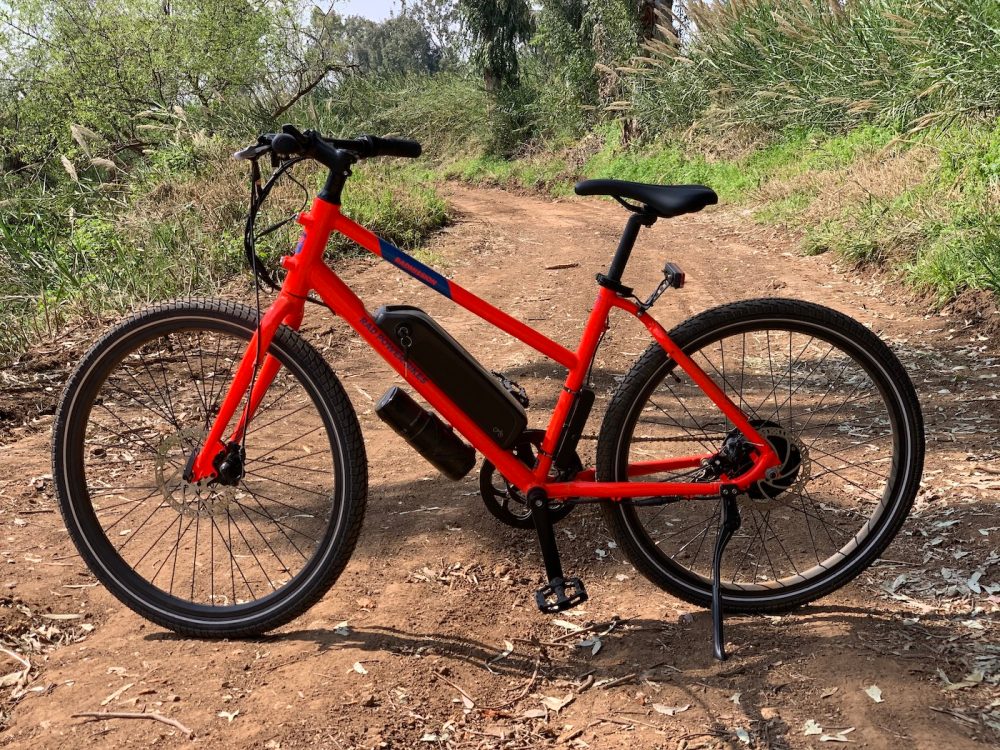
There’s nothing fancy about the RadMission’s Kenda tires, but they worked like a charm in all but the sandiest of sections. Even then, the slight fishtailing at higher speeds added a few shots of adrenaline along the way.
In fact I was actually a bit worried about getting a flat out there. We were miles from any road and while I had a spare tube in my Elite Byasi Toolbox shaped like a fake water bottle, it was only one. Two flats would make for a long walk back. But fortunately I didn’t pick anything up in my tires, and I had sufficient pressure to prevent any snake bite flats from hitting all sorts of weird rock edges.
The same can’t be said for my friend though. While riding along we suddenly heard the dismaying pffsssss noise from his front tire. He quickly hopped off his bike, lifted the front wheel up, and spun it until a white gunk began leaking. He held his finger over the hole as the sound muffled and then stopped. “Tubeless,” he said, smiling. A minute later we were rolling again. Damn, I’ve got to get me some of those…
I matched my friend’s pace as we road side-by-side for much of the trail, switching to tandem when we were met with single track.
I had expected to need to boost my assist level beyond level 1 once we reached the true off-road trails, but I soon realized that even though the riding got harder for me, it also got harder for him. Pedaling through dirt, sand, and gravel isn’t easy – even for experienced cyclists on highly efficient bikes. We both slowed a bit, but level 1 was still sufficient for me to match his pace. On hilly sections, especially when passing over depressions caused by seasonal streams and then climbing the opposite bank, I would briefly bump the assist level up to 2 or sometimes even 3 for the steeper sections. This was only the only area where the single-speed nature of the bike put me at a disadvantage, and the electric assist made up for the lack of low gearing. By and large I was able to ride in level 1 for almost all of the trail riding.
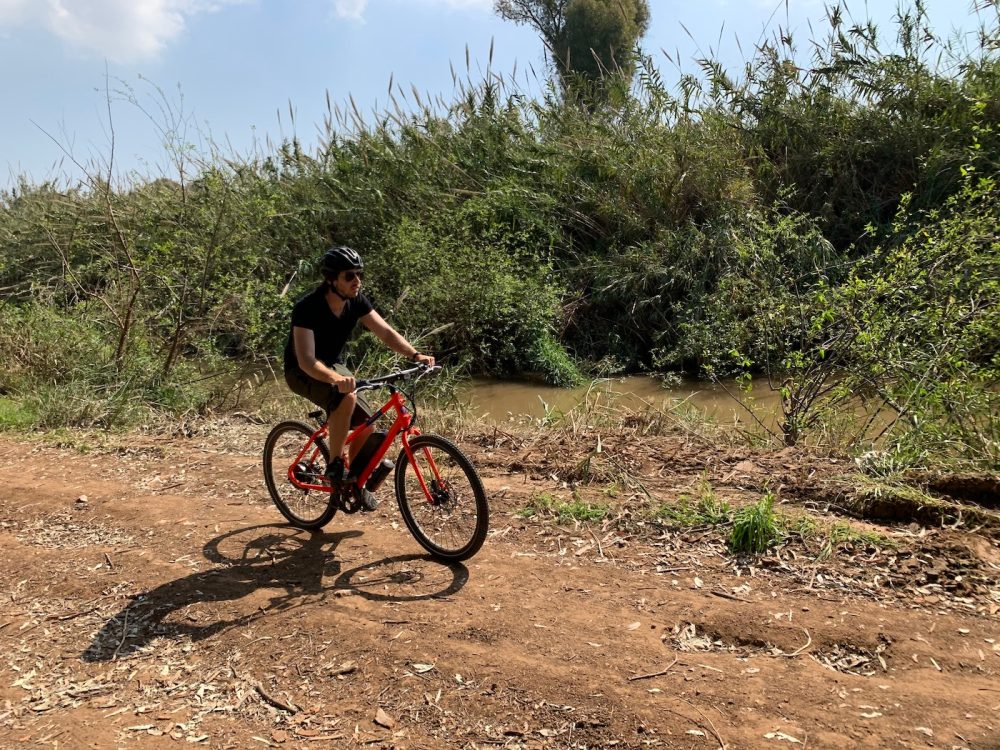
The trail got rough on occasion and I certainly spent a fair amount of time rising out of the saddle to avoid being pummeled by the irregular surface. In fact I recently ordered this cheap suspension seat post to swap on and provide a bit of suspension (you’ll need the 27.2mm version for the RadMission).
But even without any suspension (and before I have had a chance to swap on the suspension seat post), the ride was only rough for brief periods, making it definitely manageable. The worst part was probably my fingers – after nearly an hour of riding they were getting seriously spent from gripping the bars so hard. It wasn’t a matter of needing to wear gloves – the skin was fine. It was that feeling you get after climbing a high rope, the finger pump of your tired muscles that aren’t used to gripping so hard for so long. I’ve never gotten that feeling on my long pavement rides, but the shaking on uneven terrain must have caused me to grip much harder and fatigue out my finger muscles more quickly.
Around that point we decided to turn back. I was pleasantly surprised with how well the bike was holding up and how easily I had been able to keep up with my friend. My legs were tired – I was definitely working – but I wasn’t exhausted either.
I was also pleasantly surprised with my battery level. The RadMission has a very simple display and only five LED bars to indicate battery level. I hadn’t lost a single bar yet.
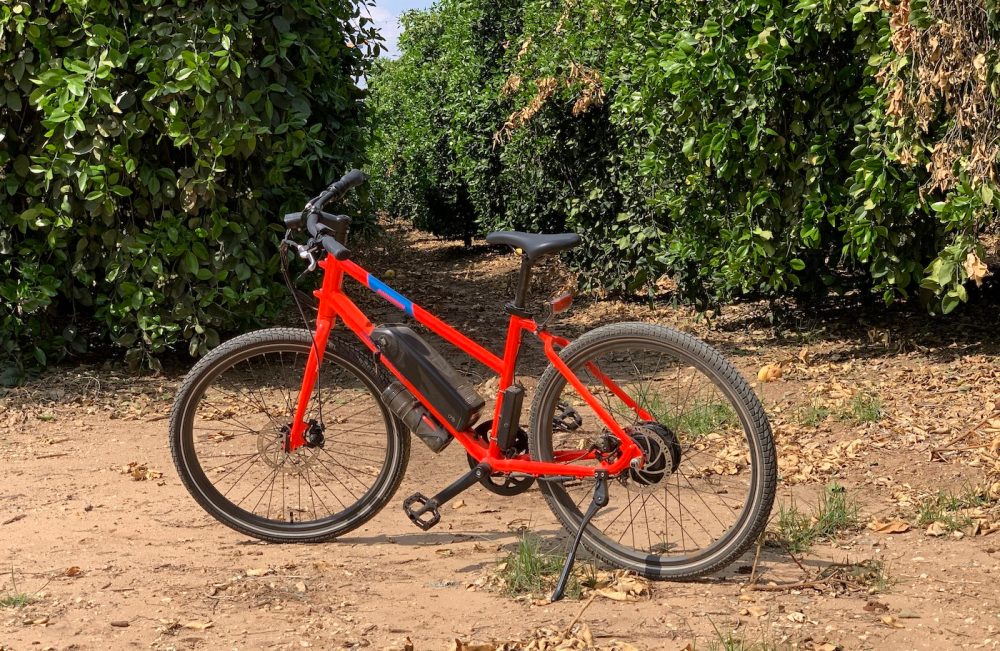
The return trip went equally well, though was peppered with occasional second-guessing when we reached forks and had brief debates about which direction we had come from.
Fortunately we chose right each time and eventually made it back into the Yarkon Park where we returned to smooth paved trails. As my friend started hitting his sprints again, I was getting a bit tired after an hour and a half in the saddle.
I rewarded myself for a strong performance by bumping up into level 2 pedal assist and matching his speed as we finished the journey with another beautiful pass along the coast.
I ultimately performed the entire ride with almost zero throttle use. I most only blipped it for a second while maneuvering the bike to turn around 180º in the middle of the trail, or for a 20 meter (60 feet) uphill section of deep sand. Probably 99.8% of the ride was pedal assist only.
Once returning, I checked my GPS tracker (I use the Runkeeper app) and fitness tracker (A cheap Fitbit Inspire HR) to see how I did.
The ride covered 34.7 km (21.6 miles) in one hour and 52 minutes – an average pace of 18.5 km/h (11.5 mph). Not bad, especially since that included stops to take photos, fix a tire, water breaks, debate which side of the fork in the path to take, etc.
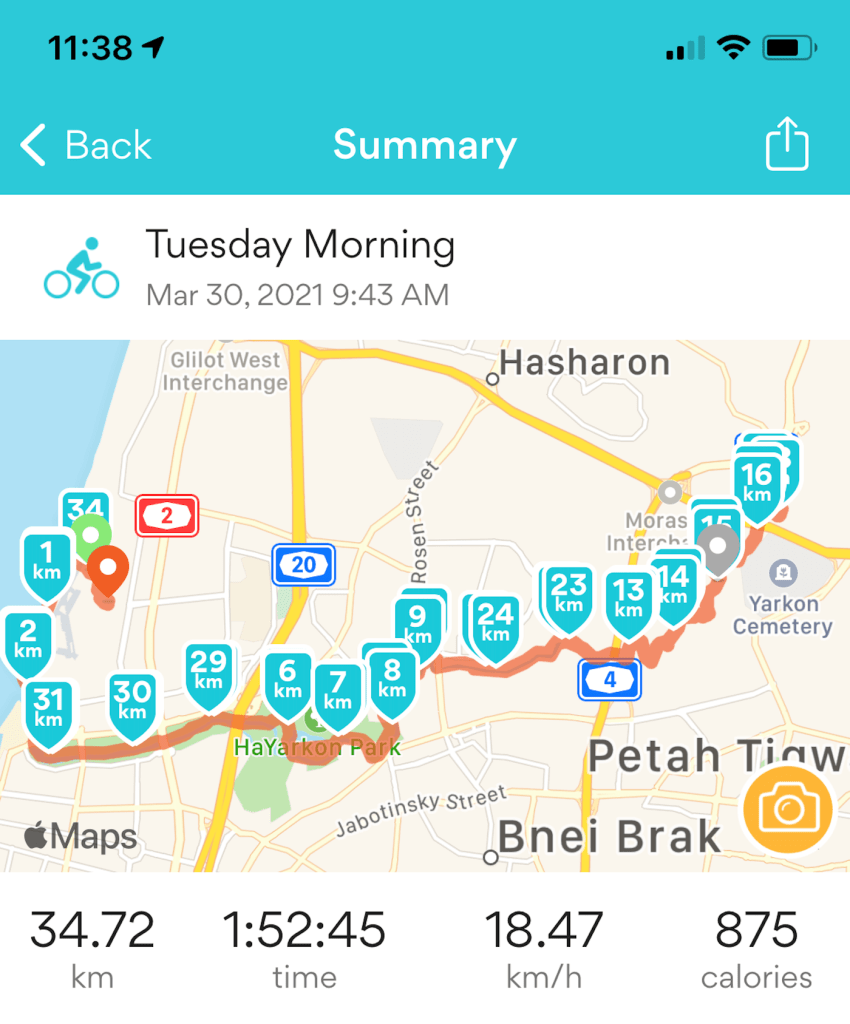
I finished the ride with four out of five battery bars left, which would presumably mean I only used 20% of my 500 Wh battery.
I measured the battery voltage at the end of the ride though to get a more accurate estimation. The voltage of 49.83V implies that I drained somewhere around 35% of the battery. That works out to an efficiency of around 5 Wh/km or 8 Wh/mi. Extrapolated to an entire pack means I theoretically could have ridden around 100 km or 62 miles.
That actually exceeds the RadMission’s range rating, and I think this is what happened: While I was riding in level 1 pedal assist, I was actually pedaling decently faster than the motor was attempting to assist me. So all it had to do was give me the boost up to its level 1 speed, and then I was doing most of the work on the top end.
I didn’t realize how much of the load was on me – I assumed the e-bike was working harder than it was. It was almost like a placebo effect. Or perhaps a low dose instead of a true placebo. Riding my e-bike made me push harder since I knew I had the assist, but ultimately the assist was set so low that I didn’t even realize I had pretty much taken the wheel.

My phone says I burned 875 calories and my Fitbit says I burned 906 calories with a 109 BPM average heart rate. Both of those calorie figures sound a bit optimistic, and fitness trackers are notorious for overestimating calorie burn, but I’m pretty happy with the heart rate. My resting rate is around 46 BPM, so that’s a decent amount of exertion for me while still keeping the experience enjoyable.
And that’s ultimately the point. I had a blast while getting in some solid exercise! My legs were tired and my fingers were sore, but it was an awesome experience and I can’t wait to do it again soon. The RadMission was able to get me out on trails, keeping up with a highly experienced cyclist and his several thousand-dollar gravel bike.
Now how long is the RadMission going to hold up to this kind of riding? I have no idea. It performed great, but surely it wasn’t designed for this. Riding trails like this every day would likely mean more frequent maintenance intervals. Who knows how those wheel bearings will hold up over time and whether the narrow quick release axle can take this punishment for years. There’s a reason real gravel e-bikes cost thousands of dollars.
But since not everyone has thousands of dollars, the fact that could help me get the same experience and a great workout at the same time is worth it to me.
I think this afternoon I’ll go for another ride. I’ve been pushing myself to do more pedal assist-only riding with a little challenge I’ve been calling #nothrottlethursdays.
I wonder how far I’ll go today?
Subscribe to Electrek on YouTube for exclusive videos and subscribe to the podcast.
Author: Micah Toll
Source: Electrek



